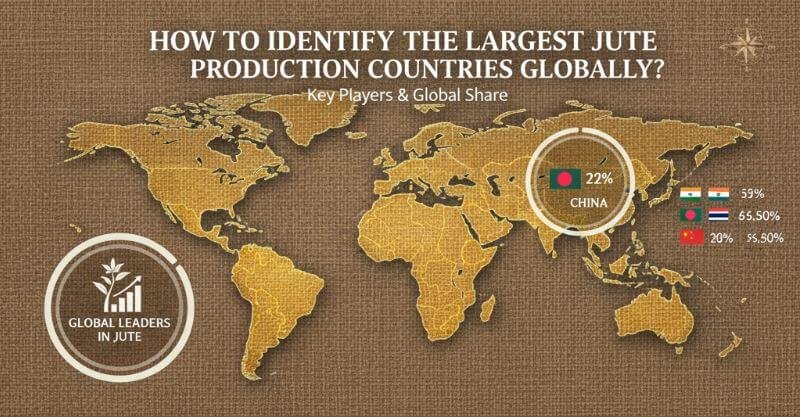Jute, often referred to as the “golden fiber,” is one of the most significant natural fibers in the world, known for its versatility and sustainability. As a biodegradable and eco-friendly material, jute has gained prominence in various industries, including textiles, packaging, and construction. Understanding global jute production is crucial not only for market stakeholders but also for consumers interested in sustainable practices. This blog post aims to explore how to identify the largest jute production countries globally, focusing on key statistics and trends.
Understanding Jute Production
Jute production refers to the cultivation and processing of jute plants, primarily Corchorus olitorius and Corchorus capsularis. This fiber is significant due to its wide array of uses, from making burlap sacks and ropes to contributing to eco-friendly packaging solutions. The demand for jute continues to grow as industries shift towards sustainable materials, making it essential to comprehend the dynamics of jute production.
Global Landscape of Jute Production
Globally, jute production is concentrated mainly in a few countries, with India being the largest producer. According to recent statistics, the total global production of jute is approximately 3 million tons annually.
Key Statistics on Global Jute Production
- India: Approximately 1.5 million tons per year
- Bangladesh: Roughly 0.9 million tons per year
- China: About 0.3 million tons per year
India contributes significantly to the world’s jute supply, making it essential to highlight its position as the leading country in jute production.
Criteria for Identifying Leading Jute Producing Countries
Several factors determine a country’s capacity for jute production:
- Climate: Jute thrives in warm, humid climates with well-drained alluvial soil. Countries with these environmental conditions are more likely to excel in jute farming.
- Technology: The adoption of modern agricultural techniques, including high-yielding seed varieties and mechanized harvesting, significantly impacts production efficiency.
- Governmental Support: Policies that promote jute farming, such as subsidies, research funding, and infrastructure development, play a crucial role in enhancing production capacity.
Understanding these criteria can help identify the leading jute-producing countries on a global scale.
Top Countries in Jute Production
1. India
India is the largest producer of jute, contributing approximately 60% of global output. The country has a long history of jute cultivation, with West Bengal being the leading state in production of jute. This region is known for its fertile soil and favorable climate, making it an ideal location for jute farming.
2. Bangladesh
Bangladesh ranks second in jute production, with a rich tradition of cultivating this fiber. The country produces around 0.9 million tons per year, and jute is often referred to as the “golden fiber” due to its economic significance. The government has implemented various policies to boost jute farming, focusing on sustainability and innovation.
3. China
China is another significant player in the jute market, producing about 0.3 million tons annually. While not as dominant as India or Bangladesh, China’s jute production is bolstered by technological advancements and increasing domestic demand for sustainable materials.
Comparison to India
When comparing jute production in these countries to that of India, it’s evident that India maintains a substantial lead. The combination of favorable climate, technological advancements, and governmental support has allowed India to excel in jute farming, making it the jute highest production in India.
Jute Production in India
India’s position in global jute production is unmatched, with states like West Bengal, Assam, and Odisha being significant contributors.
Key States in Jute Production
- West Bengal: The leading state in production of jute, contributing nearly 70% of India’s total output.
- Assam: Known for its traditional practices and increasing yield.
- Odisha: Emerging as a significant player in jute farming.
These states collectively highlight the jute production in India state wise, showcasing a robust network of farmers dedicated to this sustainable crop.
Future Trends in Global Jute Production
The future of global jute production looks promising, with emerging markets and growth areas. Innovations in jute farming practices, such as organic cultivation and integrated pest management, are gaining traction.
Predictions for Jute Production Trends
- Emerging Markets: Countries in Africa and Southeast Asia are beginning to explore jute cultivation as a sustainable alternative to synthetic fibers.
- Sustainability: As consumer awareness increases regarding environmental issues, the demand for jute is likely to rise.
Innovations and sustainability will drive the next phase of jute production, ensuring its relevance in a rapidly changing market.
Conclusion
Identifying the largest jute production countries is vital for understanding the global market landscape and the sustainability of this valuable fiber. With India leading the way, it’s essential to support sustainable jute practices globally. By promoting innovation and governmental support, we can enhance the livelihoods of farmers and ensure a sustainable future for jute.
For more insights into the economic significance of jute, explore The Economic Value of Jute as Golden Fiber. Discover how jute contributes to sustainability in Unlocking the Power of Jute: The Golden Fiber of Sustainability. Uncover the wonders of jute in The Golden Fibre: Unveiling the Wonders of Jute and understand its global market trends in Jute in the Global Market: Trends and Economic Opportunities. Learn more about innovations shaping the future of jute in How Are Innovations Impacting Jute Production in India? and the benefits of sustainable practices in Sustainable Jute Production in India: Benefits and Practices.
